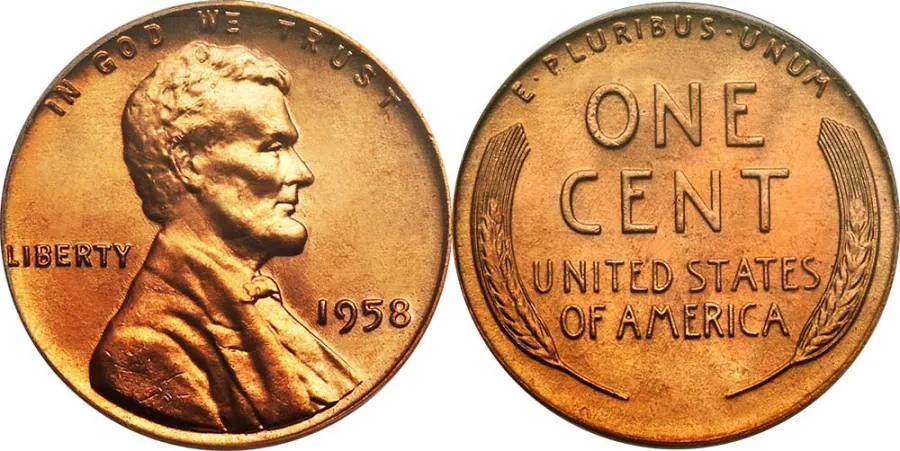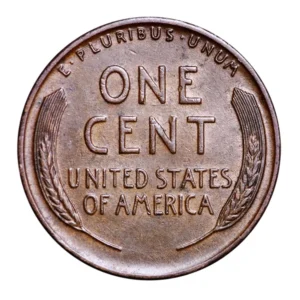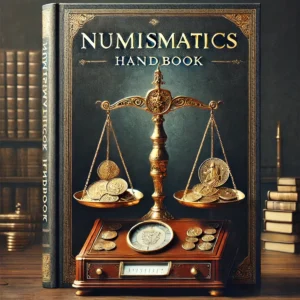Wheat Pennies: Key Dates, Errors & Value Guide (1909–1958)
Discover the history, value, and rare finds of one of America’s most iconic coins.

📘 Download the full guide: The Numismatics Handbook — A +135-page expert resource on U.S. coin collecting.
Why Wheat Pennies Matter
Wheat pennies were minted from 1909 to 1958 and feature the iconic image of Abraham Lincoln on the obverse with wheat stalks on the reverse. Known for their historical charm, affordability, and surprising rarity in some years, wheat cents remain one of the most widely collected coins in American history.

Collectors are particularly drawn to wheat pennies for:
- Key date rarities
- Minting errors
- Historical context (e.g., steel pennies from WWII)
- Accessibility to new collectors
These copper-based cents, especially early mintages, are often found in old jars, inherited collections, or estate sales. Their historical appeal and affordability make them an ideal entry point for new numismatists.
Wheat Penny Values & Key Dates by Year
Knowing the year and mint mark of your wheat penny can greatly impact its value. The table below offers general pricing for circulated coins, but uncirculated and rare varieties often sell for significantly more at auction or through dealers.
| Year | Mint Mark | Est. Value (Avg) | Rare Variant? |
|---|---|---|---|
| 1909 | S VDB | $700–$1,500 | Yes |
| 1914 | D | $200–$300 | Yes |
| 1922 | No D | $400–$1,000 | Yes |
| 1943 | Steel | $0.10–$1.50 | Common |
| 1943 | Copper | $75,000+ | Ultra Rare |
| 1955 | Dbl Die | $1,000+ | Yes |
| 1956 | D | $0.10–$0.25 | No |
If you suspect you have a valuable wheat penny, compare the coin’s condition to known grades and check for doubling, off-center strikes, or unusual minting features.

Most Valuable Wheat Pennies (Full Breakdown)
Some wheat pennies can fetch thousands — or even six figures — due to their rarity and historic significance. Here’s a deeper look at the most sought-after wheat cents:
1. 1943 Copper Wheat Penny (Over $100,000)
Minted in error during World War II, this penny was supposed to be struck in steel. Only a few copper examples were made. They are among the rarest and most valuable coins in U.S. history.
2. 1909-S VDB ($700–$1,500+)
This first-year issue featured designer Victor D. Brenner’s initials. The San Francisco version with the “VDB” is a key date with limited mintage.
3. 1914-D ($200–$300)
The 1914-D is another semi-key date with relatively low circulation. It’s one of the hardest dates to find in decent condition.
4. 1922 No D ($400–$1,000)
Denver was the only mint to strike cents in 1922, but some coins were struck without the mint mark — now considered rare errors.
5. 1955 Doubled Die Obverse ($1,000+)
One of the most famous error coins. The doubling on the date and inscriptions is visible to the naked eye.
Other valuable dates include:
- 1931-S – $60 to $100
- 1924-D – $40 to $75
- 1911-S – $30 to $60
- 1926-S – $20 to $50
- 1910-S – $20 to $40
Common Wheat Penny Errors and Variants
Wheat pennies are known for unique errors that dramatically increase their worth. Here are the most notable ones to watch for:
Doubled Die Errors
These occur when the coin is struck twice, resulting in overlapping inscriptions or dates. The 1955 DDO is the most famous.
Off-Center Strikes
A misaligned die causes the coin’s image to appear off-center. Values depend on how drastic the offset is.
No Mint Mark Variants
Some coins, especially from the early 1920s, lack a mint mark due to worn dies or minting errors. The 1922 No D is highly sought-after.
Clipped Planchets
A curved or jagged edge can signal a coin that was improperly cut during minting — another collectible error.
Pro tip: A $10 magnifying loupe can help you uncover these errors right at home.

1943 Steel vs. 1943 Copper Wheat Penny
One of the most common questions in coin collecting: What’s the deal with 1943 pennies?
During WWII, the U.S. Mint used steel coated with zinc to conserve copper for the war effort. These steel cents are very common and usually worth less than $1.
However, a few 1943 copper pennies — struck by accident — were made and are now worth $75,000+. Use a magnet to test: steel pennies stick; copper does not.
Common vs Rare Wheat Pennies
| Year | Mint Mark | Typical Value | Rarity | Notes |
|---|---|---|---|---|
| 1943 | Steel | $0.10–$1.50 | Common | Mass produced during WWII |
| 1956 D | D | $0.10–$0.25 | Common | High mintage, easy to find |
| 1909-S VDB | S | $700–$1,500 | Rare | Key date, low mintage |
| 1914-D | D | $200–$300 | Rare | Semi-key date, low mintage |
| 1943 Copper | Copper | $75,000+ | Ultra Rare | Struck in error with copper |
| 1955 Doubled Die | — | $1,000+ | Rare | Most famous doubled die |

How to Sell Your Wheat Pennies
Selling wheat pennies can be easy — if you know what to look for.
Step 1: Organize by Year and Mint Mark
Start by separating common dates from key ones (like 1909-S, 1914-D).
Step 2: Check for Errors
Use a magnifier or guidebook to spot doubled dies, off-centers, or missing mint marks.
Step 3: Determine Grade
Coins in uncirculated (MS) condition sell for significantly more. Use PCGS or NGC for official grading.
Step 4: Choose Where to Sell
- Online marketplaces (eBay, Etsy)
- Coin dealers or local coin shops
- Auction houses (like Heritage)
- Coin shows and expos
Be cautious of offers that seem too low — especially for coins with clear rarity.
How to Store and Preserve Wheat Pennies
Proper storage can maintain or even increase the value of your collection.
- Use coin flips, 2×2 holders, or acid-free cardboard sleeves
- Keep in a cool, dry environment to prevent corrosion
- Avoid PVC-containing plastic holders — they degrade coins over time
Organizing by year, mint mark, and grade can also help if you ever choose to sell or appraise your set.

FAQs About Wheat Pennies
What are the most valuable wheat pennies to look for?
The most valuable wheat pennies include the 1943 copper penny, 1909-S VDB, 1914-D, and 1955 doubled die. These rare dates and mint errors can be worth hundreds to over $100,000 depending on condition.
How much is a 1943 steel wheat penny worth today?
A 1943 steel penny is typically worth 10 to 50 cents in circulated condition. However, uncirculated examples and error varieties can sell for a few dollars.
How can I tell if I have a 1943 copper wheat penny?
Use a magnet. The 1943 copper penny will not stick, unlike the common steel version. Authentic examples are extremely rare and can be worth over $75,000.
What is the value of a 1909-S VDB wheat penny?
In circulated condition, a 1909-S VDB penny ranges from $700 to over $1,500. Uncirculated specimens with red luster can sell for several thousand dollars.
What does “No D” mean on a 1922 wheat penny?
The 1922 No D refers to a wheat penny minted in Denver with the mint mark accidentally missing. It is considered a mint error and is highly collectible, often worth $400–$1,000.
How do I know if my wheat penny has a doubled die?
Look closely at the date and lettering using a magnifying loupe. Doubled die wheat pennies show clear doubling, especially on the 1955 DDO which has bold, visible doubling on the front.
What are the key dates in wheat pennies?
Key dates include 1909-S VDB, 1914-D, 1922 No D, 1931-S, and 1955 DDO. These coins are rare due to low mintage or striking errors and command premium prices.
Should I clean my wheat pennies before selling them?
No. Cleaning wheat pennies can damage the surface, reduce grade, and significantly lower value. Leave coins in their original condition.
Where is the mint mark located on a wheat penny?
The mint mark is found below the date on the obverse (front) of the coin. Common marks include “D” for Denver, “S” for San Francisco, and no mark for Philadelphia.
Are all wheat pennies worth money?
Most wheat pennies from the 1940s and 1950s are worth a few cents to a dollar. However, rare dates and error coins can be worth hundreds or even thousands of dollars.
